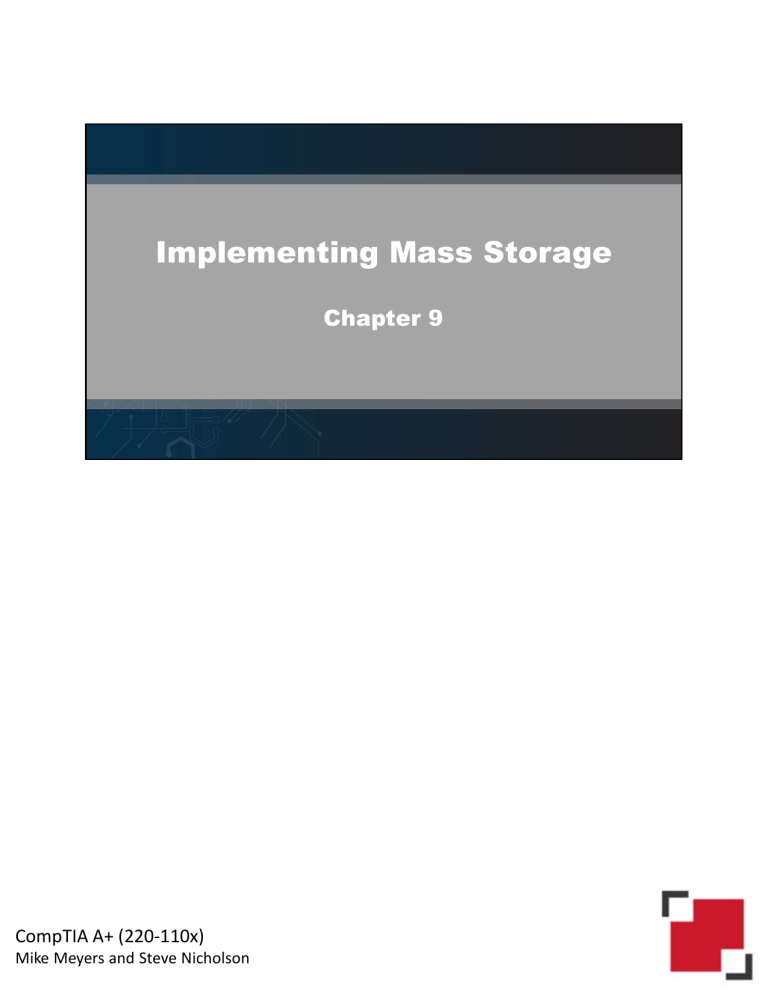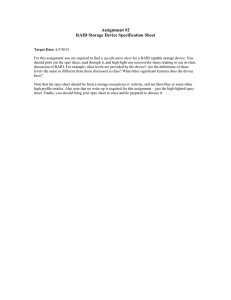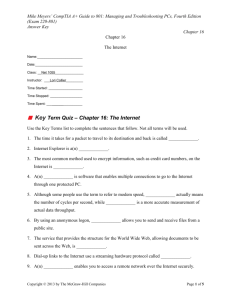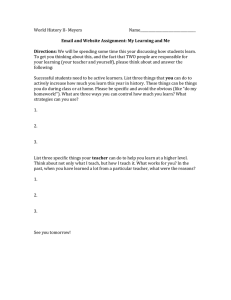
Implementing Mass Storage Chapter 9 CompTIA A+ (220-110x) Mike Meyers and Steve Nicholson Episode: RAID Core 1: 3.3 Given a scenario, select and install storage devices. Objective(s): Core 1: 5.3 Given a scenario, troubleshoot and diagnose problems with storage drives and RAID arrays. CompTIA A+ (220-110x) Mike Meyers and Steve Nicholson Episode Description The Random Array of Independent (or Inexpensive) Disks (RAID) is a philosophy of using multiple drives working as a single drive – an array – for speed or redundancy. A good tech should understand the many RAID levels and the benefits they provide. CompTIA A+ (220-110x) Mike Meyers and Steve Nicholson Key Terms • 0:52 - Objective term - Redundant Array of Inexpensive Disks (RAID) CompTIA A+ (220-110x) Mike Meyers and Steve Nicholson Quick Review RAID provides speed and/or redundancy RAID 0 (striping) provides speed RAID 1 (mirroring) provides redundancy RAID 5 (striping with parity) provides speed and redundancy but can only lose one drive • RAID 6 (striping with parity) provides speed and redundancy but can lose two drives • • • • CompTIA A+ (220-110x) Mike Meyers and Steve Nicholson Episode: Hardware RAID Core 1: 3.3 Given a scenario, select and install storage devices. Objective(s): Core 2: 1.9 Given a scenario, perform OS installations and upgrades in a diverse OS environment. CompTIA A+ (220-110x) Mike Meyers and Steve Nicholson Episode Description Hardware RAID uses a purpose-built RAID controller to configure and maintain RAID arrays. It’s important to understand the benefits of hardware RAID and how to configure and maintain RAID arrays. CompTIA A+ (220-110x) Mike Meyers and Steve Nicholson Key Terms • 2:57 - <CTRL-R> • 5:33 - Objective term - Hot spare/ swappable drive CompTIA A+ (220-110x) Mike Meyers and Steve Nicholson Quick Review • Hardware RAID requires a controller to configure the RAID arrays • Hardware RAID has its own BIOS that comes with a special system setup to configure the RAID array • The completed array looks like a single drive to the operating system CompTIA A+ (220-110x) Mike Meyers and Steve Nicholson Episode: Software RAID in Storage Spaces Core 1: 3.3 Given a scenario, select and install storage devices. Objective(s): Core 2: 1.3 Given a scenario, use features and tools of the Microsoft Windows 10 operating system (OS). CompTIA A+ (220-110x) Mike Meyers and Steve Nicholson Episode Description Microsoft’s Storage Spaces feature provides a superb tool to configure many different RAID configurations on any Windows system. A good tech knows which types of RAID it supports and how to set them up. CompTIA A+ (220-110x) Mike Meyers and Steve Nicholson Key Terms • 3:57 - Just a bunch of disks (JBOD) • 7:00 - Three-way mirror CompTIA A+ (220-110x) Mike Meyers and Steve Nicholson Quick Review • Software RAID uses the operating system to configure the RAID array • Windows comes with a powerful tool called Storage Spaces to configure advanced software RAID arrays • Storage Spaces provides superb flexibility CompTIA A+ (220-110x) Mike Meyers and Steve Nicholson Episode: Encrypting Mass Storage Objective(s): CompTIA A+ (220-110x) Core 1: 3.4 Given a scenario, install and configure motherboards, central processing units (CPUs), and add-on cards. Core 2: 2.5 Given a scenario, manage and configure basic security settings in the Microsoft Windows OS. Mike Meyers and Steve Nicholson Episode Description Securing mass storage is a critical aspect of system security. Make sure you know the many ways a system’s mass storage can be encrypted. CompTIA A+ (220-110x) Mike Meyers and Steve Nicholson Key Terms • • • • • • • • 0:32 - Objective term - Encryption 1:01 - File-based encryption 1:04 - Disk-based encryption 1:41 - Objective term - Encrypting File System (EFS) 4:23 - Objective term - BitLocker for Windows 4:28 - Objective term - FileVault for macOS 4:46 - Objective term - Trusted Platform Module (TPM) 7:55 - Objective term - BitLocker To Go CompTIA A+ (220-110x) Mike Meyers and Steve Nicholson Quick Review • File-based encryption encrypts files and folders; disk-based encryption encrypts entire drives • Windows uses Encrypted File System (EFS) to encrypt folders and files • Windows uses Bitlocker to encrypt entire hard drives • Bitlocker requires a system with a Trusted Platform Module (TPM) chip CompTIA A+ (220-110x) Mike Meyers and Steve Nicholson Episode: Mass Storage Troubleshooting Objective(s): CompTIA A+ (220-110x) Core 1: 5.3 Given a scenario, troubleshoot and diagnose problems with storage drives and RAID arrays. Mike Meyers and Steve Nicholson Episode Description Mass storage devices sometimes fail, resulting in the potential loss of critical data. A good tech knows the tools and procedures to diagnose and repair many mass storage problems. CompTIA A+ (220-110x) Mike Meyers and Steve Nicholson Key Terms • • • • 0:29 - 1. Back it up 0:47 - 2. Mental reinstall 1:04 - 3. Triple check 1:30 - Objective term - RAID not found/RAID not working • 2:41 - Objective term - Read/write failure or extended read/write times • 3:03 - Objective term - Self-Monitoring, Analysis, and Reporting Technology (S.M.A.R.T.) CompTIA A+ (220-110x) Mike Meyers and Steve Nicholson Key Terms • 3:31 - Objective term - Slow/sluggish performance • 4:01 - Objective term - Red LED status indicator • 4:13 - Objective term - Loud clicking/grinding noises • 4:36 - Failure to boot • 5:06 - Objective term - Drive not recognized/bootable device not found/missing drives • 5:38 - OS not found • 6:15 - Attempts to boot incorrect device • 6:29 - Continuous reboots CompTIA A+ (220-110x) Mike Meyers and Steve Nicholson Quick Review • Always back up important data before troubleshooting mass storage • Use a mental process of installation to make sure all the installation steps have taken place • Review the many symptoms in this episode! CompTIA A+ (220-110x) Mike Meyers and Steve Nicholson



